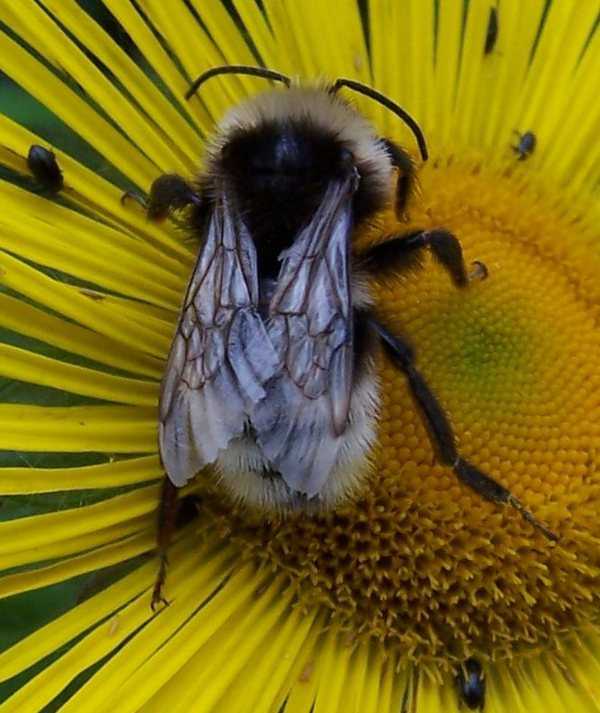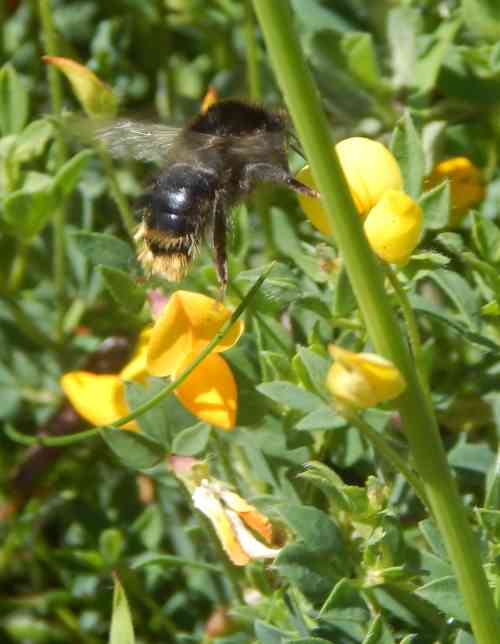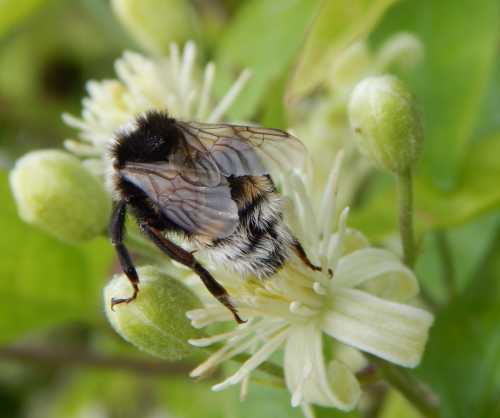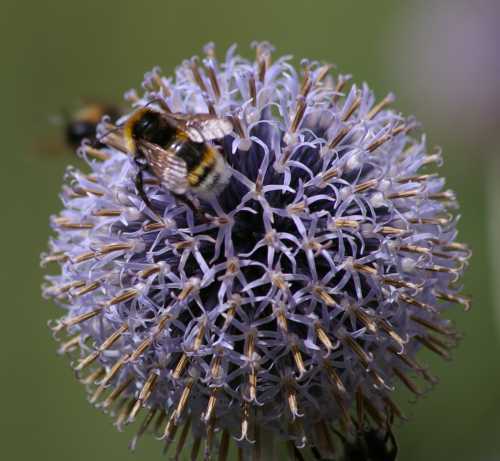The Cuckoo Bumble Bee
Updated: 1st March 2023
Cuckoo bumble bees are obligate brood parasites of
nest-building bumble bees of the genus Bombus. They belong to the sub-genus, Psithyrus.
The female cuckoo lays its eggs in the nests of true social Bombus species.
Here we'll take a look at the behaviours of cuckoo bumble bee species.
What Are Cuckoo Bumble Bees?
 Bombus barbutellus - Barbut's cuckoo bee - male.
Bombus barbutellus - Barbut's cuckoo bee - male.
Cuckoo bumble bees are obligate social parasites of
nest-building bumble bees of the true social genus Bombus1,2.
Michener (2000) defined a social parasite as a female that enters a nest of the social host and in some way replaces the queen, so that host workers thereafter rear offspring of the parasite1.
They are 'obligate' in that they are completely dependent on the host for the rearing of its offspring1,2.
Obligate social parasites produce sexual offspring only (i.e. females that will mate with males rather than producing workers that provide for the colony), and depend on host workers for all other resources2.
There is a lack of worker caste3. The female cuckoo merely lays eggs to create future breeding females like herself, and males3.
The female offspring are likewise limited, in that they cannot perform the tasks that worker bees of the social species undertake, in order to sustain the colony.
Cuckoos are also 'inquilines'1.
The term inquiline refers to an organism that shares the nest of the host, rather than simply depositing an egg then leaving.
How are cuckoos different from social bumble bees?Although the physical appearance of cuckoos resembles that of the social species, there are key physical differences which result in a modification of their behaviours in comparison with their social bumble bee hosts.
- Wax secretion
Cuckoos do not have the ability to excrete wax from their abdomens1 for making egg cells in which to lay their eggs, nor can they make honey pots from which newly emerged brood may feed, and from which they may feed themselves whilst they incubate the brood (see the bumble bee life cycle ).
Therefore, the cuckoo female must use the larval cells and cups made by the host queen. - Pollen collecting
The cuckoo female also cannot collect pollen since she has no pollen baskets (or corbicula) on the hind legs1,2 .
Pollen is nutritionally important for bees, particularly feeding brood.
In order to produce, cuckoo bumble bees must therefore rely on the host colony, since cuckoos are unable to provide for their offspring, nor establish their own nests.
This means cuckoos (Psithyrus) are completely dependent on the host for future survival of the species.
What is the life cycle of a cuckoo bumble bee?
Cuckoo
females typically emerge from hibernation in spring, later than their target host species3.
They will have been fertilized by a male the previous year, and they begin foraging on flowers whilst their ovaries develop3.
They will seek out a host nest. Some cuckoos target only one
specific species of bumble bee, whilst others may select from two or
three target hosts3.
Upon finding a host, then assuming she is able to successfully enter the nest and rear young, she will produce breeding females and males. The breeding females will emerge from the nest, mate, then hibernate until the following year.
 Bombus campestris - Field cuckoo bee - male.
Bombus campestris - Field cuckoo bee - male.Selecting a suitable host
A cuckoo must select a host nest that is at an appropriate stage of development3.
There must be a colony already
established of at least a few workers to help the cuckoo rear her
offspring. On the other hand, if there are too many workers in the
nest, she may be attacked and easily defeated3.
If a cuckoo enters a nest before 2 broods have been reared, she will usually be successful in establishing herself in the nest3.
How do cuckoo bumble bees take over a host nest? Chemical Weaponry!
Once the cuckoo has found a suitable nest, she will typically lurk around it for some time, in order to ‘pick up the scent’ of the host before entering4.
It is suggested the scent helps the cuckoo discriminate between potential hosts, and comes from the Dufour's gland of the host2.
Cuckoo bumble bee females have large Dufour's glands, and it has been suggested that cuckoo females may smear the glands’ contents on their cuticle1 (see - exoskeleton).
It has been proposed that if the 'chemical signature' (pheromones) of the cuckoo species is similar to the target host, then this might help facilitate the cuckoo's integration into the host nest2.
 Bombus vestalis - Vestal cuckoo bee - male.
Bombus vestalis - Vestal cuckoo bee - male.However, the process of nest usurption and dominance is highly variable depending on species2,3 .
For example, these social parasite bumble bees may engage in a variety of behaviours to defend their position in the nest, or/and dominate it, and responses from hosts may differ:
- passively usurp host colonies without aggression1,2;
- maul their hosts to establish dominance1,2, a behaviour which may include grasping host workers and queen, pulling them under their body and engage in threatening stinging movements1;
- use allomones to defend themselves against attacking host workers1;
- secure a colony’s reproductive resources by eating the host queen’s eggs2,3;
- use chemical secretions to inhibit ovarian development in workers2,4;
- the host queen may be killed, sometimes along with at least some workers3,4;
- a host queen may become 'subservient' and begin behaving as a worker3;
- however,
some cuckoo species cohabit with the host queen
and do not interfere with worker development2,3,4.
Indeed Benton4 quotes a number of studies which may indicate both cuckoo and host had 'reproductive success.
Is the true queen always killed?
Not always, though she may be. Although cuckoos closely resemble social species, the female parasite is often a little larger than her host.
She has a more powerful, longer sting, and a thicker, though less hairy coat. She can often overpower the founder queen unless there are sufficient workers to attack her.
As stated previously, cases have been noted where cuckoo and host both survive and produce offspring, including new queens (gynes) in the case of the host, for example, as noted in a study by Küpper & Schwammberger (1995)5 in observations of Bombus pratorum nests attacked by the cuckoo, Bombus (Psithyrus) sylvestris.
 Bombus vestalis - Vestal cuckoo bee - foraging on Echinops.
Bombus vestalis - Vestal cuckoo bee - foraging on Echinops.Are cuckoos always successful against social bumble bees
No. Research has also shown that the cuckoo is not always successful at establishing herself in the host nest. She may be attacked and killed by the target host queen and workers3.
Do cuckoo bumble bees pollinate plants?
Social bumble bees species are renowned pollinators. Workers are industrious, and are able to 'buzz pollinate'.
Technically, cuckoo species are able to transfer pollen from flower to flower during foraging, thereby aiding the process of pollination.
However, cuckoos spend comparatively little time foraging, do not actively collect pollen, and therefore are unlikely to be such effective pollinators and in this respect they differ from their hosts.
Distribution - Where can we find cuckoo species?
According to The Bees in Your Backyard: A Guide to North America's Bees there are 29 species of Bombus (Psithyrus).
However, only 6 of these cuckoo species occur in the United States and Canada.
Regulators have used interesting methods to provide species with legal protection - see 'Are Bees Fish In California?'.
There are 10 species of cuckoo bumble bee in Europe – 6 species may be found in Britain5.
North American Cuckoo Bumble Bees And Their Hosts
- Bombus suckleyi - Suckley Cuckoo Bumble Bee - recorded as breeding as a parasite of colonies of Bombus occidentalis.
Also recorded as present in the colonies of Bombus terricola, Bombus rufucinctus, Bombus fervidus, Bombus nevadensis and Bombus appositus. - Bombus insularis - Indiscriminate Cuckoo Bumble Bee -
recorded as breeding as a parasite of colonies of
Bombus appositus, Bombus nevadensis, Bombus fervidus, Bombus flavirons, and Bombus ternarius.
Also recorded as present in the colonies of Bombus terricola, Bombus rufucinctus, Bombus occidentalis, and Bombus nevadensis. - Bombus bohemicus - Ashton's Cuckoo Bumble bee - recorded as breeding as a parasite of colonies of Bombus terricola and Bombus affinis.
Also likely to breed in colonies of Bombus occidentalis and Bombus cryptarum.
- Bombus variabilis - Variable Cuckoo Bumble bee -
recorded as breeding as a parasite of colonies of Bombus pensylvanicus. - Bombus citrinus - Lemon Cuckoo Bumble Bee -
recorded as breeding as a parasite of colonies of Bombus impatiens, Bombus bimaculatus, and Bombus vagans. - Bombus flavidus - Fernald Cuckoo Bumble Bee - No direct records of it actually breeding in the colonies of host species in North America, though it has been recorded as present in colonies of Bombus rufucinctus, Bombus occidentalis and Bombus appositus.
Read about the status of cuckoo bumble bees found in North America (according to the IUCN).
British Cuckoo Bumble Bee Species And Their Hosts
- Bombus bohemicus - Gypsy Cuckoo Bee
targets Bombus lucorum. - Bombus vestalis -Vestal Cuckoo Bee
targets Bombus terrestris. - Bombus barbutellus - Barbut's Cuckoo Bee
targets both Bombus hortorum and Bombus rudertatus. - Bombus rupestris - Red-tailed Cuckoo Bee
targets Bombus lapidarius. - Bombus sylvestris - Forest Cuckoo Bee
targets Bombus pratorum and possibly Bombus jonellus and Bombus monticola. - Bombus campestris - Field Cuckoo Bee
targets Bombus pascuorum, Bombus humilis and previously, Bombus pomorum (now extinct in Britain, but likely due to habitat loss).
What Should We Do About Cuckoo Bumble Bees?
Take a look at this list of bee plants.
You might also wish to look at my page which provides 10 simple ways to help
save the bees.
References
1. Zimma B.O. et al (2003) Do social parasitic bumble bees use chemical weapons? (Hymenoptera, Apidae) J Comp Physiol A (2003) 189: 769–775 (DOI 10.1007/s00359-003-0451-x)
2. Bumblebee inquilinism in Bombus (Fernaldaepsithyrus) sylvestris (Hymenoptera, Apidae): behavioural and chemical analyses of host-parasite interactions. Stéphanie Dronnet, Xavier Simon, Jean-Claude Verhaeghe, Pierre Rasmont and Christine Errard Apidologie, 36 1 (2005) 59-70 DOI: https://doi.org/10.1051/apido:2004070
3. Goulson, D. 2010. Bumblebees, Behavior and Ecology. Oxford Univ. Press, Oxford, U.K, Pp. 81.
4. Benton, Ted. Bumblebees: The Natural History & Identification of the Species Found in Britain. Collins 2006.
5. Social parasitism in bumble bees (Hymenoptera, Apidae): observations of Psithyrus sylvestris in Bombus pratorum nests, G. Küpper, K. H. Schwammberger
Apidologie 26 (3) 245-254 (1995)
DOI: 10.1051/apido:19950306.
6. Field Guide to the Bees of Great Britain and Ireland by Steven Falk, Bloomsbury 2015.
If you found this page helpful or interesting, I'd really be grateful if you would share it with others - if not this page, perhaps another, such as Gardening For Bees.
Thank you so much :) .